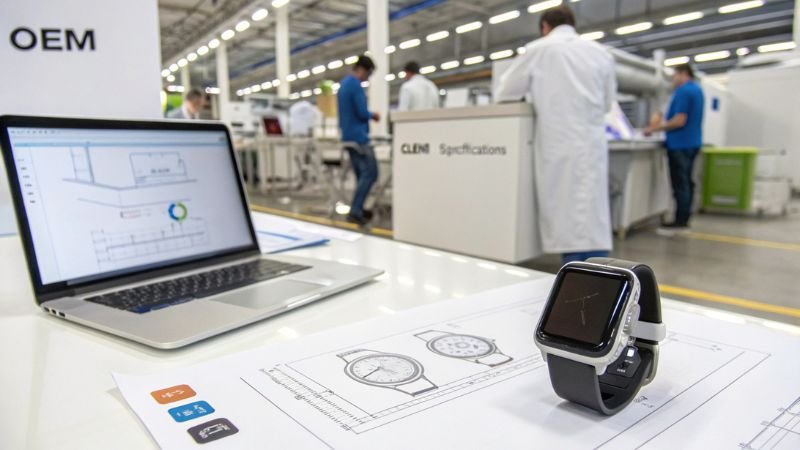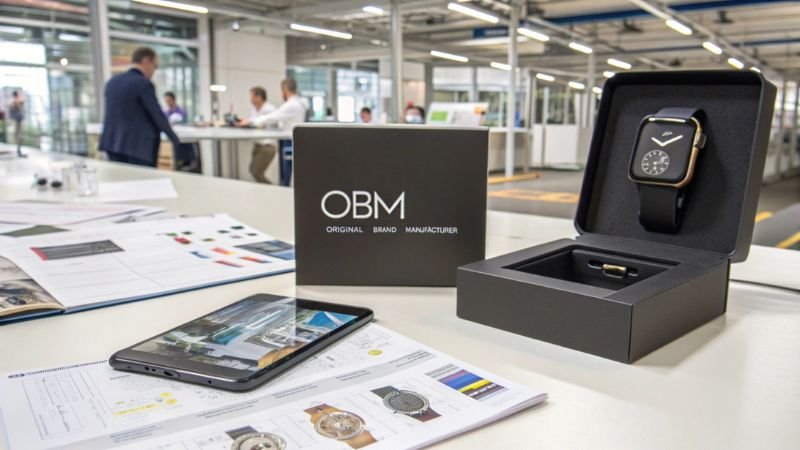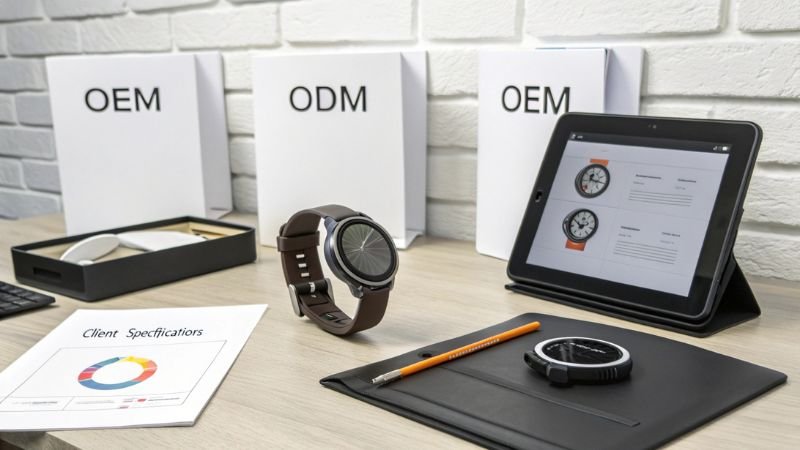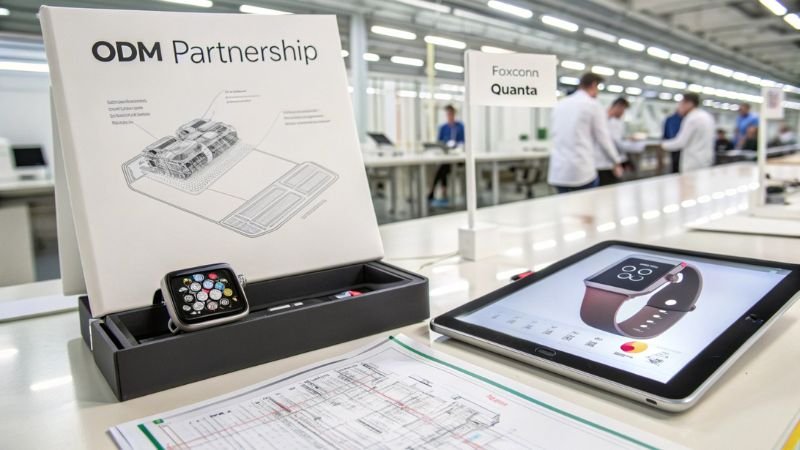What Do OEM, OBM, and ODM Mean for Your Smart Watch Business?

The smartwatch market is experiencing unprecedented growth, driven by technological advancements and increasing consumer demand for connected devices. For distributors, wholesalers, business owners, importers, e-commerce sellers, Amazon or Shopify sellers, and tech entrepreneurs, understanding the different manufacturing models—OEM, OBM, and ODM—is crucial. These models dictate how your smartwatches are designed, produced, and branded, directly influencing your business’s efficiency, cost structure, and market positioning.
OEM, OBM, and ODM are foundational manufacturing models in the smartwatch industry, each offering unique advantages and considerations.
This comprehensive guide explores OEM, OBM, and ODM in the context of smartwatch manufacturing, highlighting their differences, advantages, and strategic implications to help you make informed decisions for your business.
What Are OEM, OBM, and ODM in Smart Watch Manufacturing?
OEM, OBM, and ODM are distinct manufacturing models that define the roles and responsibilities in the production and branding of smartwatches. Each model offers varying degrees of involvement in design, manufacturing, and branding, catering to different business needs and strategic objectives.

1. OEM (Original Equipment Manufacturer)
Definition:
An OEM1 produces smartwatches based on the client’s proprietary designs and specifications. In this model, the client retains full control over the product design, branding, and intellectual property.
Key Characteristics:
- Design Ownership: The client owns the product design and intellectual property.
- Customization: Limited to the client’s specifications; any changes require adjustments to the original design.
- Production Control: High level of control over the manufacturing process to ensure the final product meets the client’s standards.
- Branding: The client handles all branding, packaging, and marketing efforts.
Advantages:
- Full Design Control: Ensures the product aligns perfectly with the brand’s vision and market requirements.
- Brand Exclusivity: Unique products that differentiate the brand in a competitive market.
- High-Quality Standards: Direct oversight of manufacturing processes to maintain high-quality standards.
Disadvantages:
- Higher Initial Investment: Requires significant investment in design and development.
- Longer Time-to-Market: Designing a product from scratch can extend the development timeline.
- Dependency on Client’s Design Capability: Success heavily relies on the client’s ability to create a market-ready design.
Example:
A tech startup designs a unique smartwatch with proprietary health-tracking features. They partner with an OEM in Shenzhen to manufacture the watch according to their exact specifications, ensuring the final product matches their innovative design.

2. OBM (Original Brand Manufacturer)
Definition:
An OBM2 not only manufactures the smartwatch but also handles branding, marketing, and distribution under the client’s brand name. OBMs offer a more integrated solution, managing multiple aspects of the product lifecycle.
Key Characteristics:
- Design and Branding: OBMs often collaborate with clients to develop product designs and handle branding efforts.
- Turnkey Solutions: Provides end-to-end services from design to distribution, simplifying the manufacturing process for the client.
- Market Adaptation: Can adjust products to fit specific market trends and consumer preferences, enhancing your brand’s relevance.
Advantages:
- Comprehensive Service: Reduces the need for the client to manage multiple suppliers for design, production, and branding.
- Speed to Market: Streamlined processes can accelerate product development and launch.
- Brand Development Support: OBMs can offer expertise in building and strengthening brand identity.
Disadvantages:
- Less Design Control: Clients may have less input into the design process compared to OEMs.
- Potential Higher Costs: Comprehensive services can come at a premium price.
- Dependency on OBM’s Expertise: Success relies on the OBM’s ability to effectively manage both manufacturing and branding.
Example:
A fashion brand wants to launch a stylish smartwatch line without investing heavily in design and branding. They partner with an OBM that not only manufactures the watches but also assists in creating the brand’s unique identity and marketing strategy.

3. ODM (Original Design Manufacturer)
Definition:
An ODM3 designs and manufactures smartwatches which you can then brand and market. ODMs offer more design flexibility compared to OEMs, providing innovative designs that clients can customize with their branding.
Key Characteristics:
- Design Ownership: The ODM owns the initial design, which clients can customize.
- Customization: Clients can modify aspects of the design such as color, materials, and branding elements.
- Product Innovation: ODMs often develop new designs and features, allowing clients to offer unique products without extensive in-house R&D.
Advantages:
- Design Flexibility: Clients can customize existing designs to better fit their brand without starting from scratch.
- Reduced R&D Costs: Leveraging the ODM’s design expertise can save on research and development expenses.
- Faster Time to Market: Utilizing pre-designed products can accelerate the production and launch process.
Disadvantages:
- Less Design Control: Clients have limited influence over the core design compared to OEMs.
- Potential Brand Overlap: If multiple clients use the same ODM designs, products may lack uniqueness.
- Intellectual Property Concerns: Sharing design requirements with ODMs may raise IP protection issues if not properly managed.
Example:
A new e-commerce brand wants to offer smartwatches with unique features but lacks the design expertise. They partner with an ODM that provides innovative smartwatch designs, which the brand customizes with their logo, packaging, and specific feature enhancements.

How Do OEM, OBM, and ODM Differ in Smart Watch Production?
Understanding the distinctions between OEM, OBM, and ODM is crucial for selecting the right manufacturing model that aligns with your business needs and capabilities. Here’s a detailed comparison to help you make an informed decision:

Comparative Analysis
| Aspect | OEM (Original Equipment Manufacturer) | OBM (Original Brand Manufacturer) | ODM (Original Design Manufacturer) |
|---|---|---|---|
| Design Ownership | Fully owned by the client | Joint or manufacturer-owned | Manufacturer-owned, customizable |
| Customization | Strictly client-defined | High flexibility in branding and design integration | Flexible customization within existing designs |
| Branding | Fully managed by the client | Managed by the manufacturer | Managed by the client |
| Service Scope | Manufacturing only | Full-service solution | Design and manufacturing |
| Time-to-Market | Longer, due to design development | Moderate | Short, leveraging pre-designed models |
| Investment Required | High (design and R&D) | High (comprehensive services) | Moderate (leveraging existing designs) |
| Control Over Production | High | Moderate | Low to moderate |
| Intellectual Property | Fully retained by the client | Shared or negotiated | Shared; clients brand the design |
| Cost Structure | Higher upfront investment for design | Higher costs due to added services | Cost-efficient, leveraging existing designs |
Practical Implications:
-
OEM:
Best suited for established businesses with proprietary designs seeking precise and high-quality production. -
OBM:
Ideal for brands aiming for a full-service approach, handling everything from design to marketing and distribution. -
ODM:
Perfect for startups or businesses looking to enter the market quickly with innovative and customizable products without heavy investment in R&D.
What’s the Core Difference Between OEM, ODM, and OBM for Smart Watches?
The core differences among OEM, ODM, and OBM revolve around design ownership, branding responsibilities, and the extent of production control. Understanding these differences helps in making strategic decisions that align with your business goals.

1. Design Ownership
-
OEM:
- You Provide the Design: Full ownership and control over the product’s design and intellectual property.
-
ODM:
- Manufacturer Provides the Design: The ODM creates the initial design, which you can customize and brand.
-
OBM:
- Combined Ownership: OBMs may collaborate on design while managing branding and marketing, sharing design responsibilities.
2. Branding and Marketing
-
OEM:
- Client-Focused Branding: All branding, packaging, and marketing are managed by the client, ensuring brand consistency.
-
ODM:
- Shared Branding Efforts: Clients brand the manufacturer’s design, often handling marketing independently.
-
OBM:
- Manufacturer-Managed Branding: OBMs oversee branding and marketing, providing a turnkey solution for the client.
3. Customization and Flexibility
-
OEM:
- Limited Customization: Customization is restricted to the client’s original specifications, requiring redesigns for significant changes.
-
ODM:
- Flexible Customization: Clients can modify existing designs to better fit their brand’s identity and market demands.
-
OBM:
- Comprehensive Customization: Includes customization of design, packaging, and marketing materials, offering high flexibility.
Practical Example:
When launching my smartwatch brand, I chose an ODM partner. They provided innovative designs that I could customize and brand as my own, allowing me to focus on marketing and sales without worrying about the complexities of design and manufacturing.
What Does OEM Mean in the Smart Watch Industry?
OEM (Original Equipment Manufacturer) in the smartwatch industry refers to manufacturers that produce smartwatches based on a client’s specific designs and requirements. This model is highly beneficial for businesses that have established designs and need reliable manufacturing partners to bring their products to life.

Understanding OEM
Customization:
OEMs provide complete control over the smartwatch’s design and specifications. Clients can tailor every aspect of the product, from hardware components to software features, ensuring the final product aligns perfectly with their brand’s vision.
Quality Assurance:
OEM manufacturers implement rigorous quality control measures to ensure that each smartwatch meets the client’s standards. This includes testing for durability, functionality, and aesthetic consistency, which is crucial for maintaining brand reputation.
Flexibility:
Clients have the ability to make design changes as needed, allowing them to respond to market trends and consumer feedback. This flexibility is essential for businesses that prioritize innovation and adaptability.
Benefits of OEM
| Benefit | Description |
|---|---|
| Design Control | Full ownership and control over the product design ensures alignment with your brand’s identity and market strategy. |
| Brand Exclusivity | Unique products that stand out in the market, enhancing your brand’s exclusivity and appeal. |
| Scalability | Ability to scale production based on demand without design constraints, supporting business growth. |
| Quality Consistency | Direct oversight of manufacturing processes maintains high-quality standards across all units. |
| Intellectual Property Protection | Retaining ownership of the design safeguards your innovations and prevents unauthorized replication. |
Personal Experience
I partnered with an OEM manufacturer to produce smartwatches based on my unique design. This collaboration allowed me to offer a distinct product that stood out in the competitive market. The OEM ensured that every unit met my quality standards, and their flexibility in making design adjustments as needed was invaluable. As a result, my brand gained a reputation for high-quality, reliable smartwatches, leading to increased sales and customer satisfaction.
Is Apple an OEM or ODM in Smart Watch Production? Lessons for Your Business
Apple operates primarily as an ODM (Original Design Manufacturer) in smartwatch production, collaborating with renowned manufacturers like Foxconn and Quanta to design and produce the Apple Watch. This strategic partnership allows Apple to maintain its focus on innovation and branding while leveraging the manufacturing expertise of its ODM partners.

Apple’s Manufacturing Model: ODM in Action
-
Collaborative Design and Innovation:
- Apple develops the design, features, and software for the Apple Watch, focusing on innovation and user experience.
- ODM partners handle the production logistics, ensuring that the design specifications are accurately executed.
-
Leveraging ODM Expertise:
- Partners like Foxconn and Quanta bring advanced manufacturing capabilities, high precision, and scalability to meet Apple’s production demands.
- ODMs provide state-of-the-art facilities and skilled labor, enabling Apple to produce high-quality smartwatches efficiently.
-
Rigorous Quality Assurance:
- Apple implements stringent quality control processes throughout the production cycle, from component testing to final assembly.
- Ensures that every Apple Watch meets its high standards for performance, durability, and aesthetics.
-
Focus on Branding and Market Leadership:
- Apple retains complete control over branding, marketing, and customer experience, ensuring a cohesive and premium brand image.
- ODM partnerships allow Apple to focus resources on R&D, marketing strategies, and enhancing the user experience.
Lessons for Your Business
Apple’s ODM-driven approach offers valuable insights for smartwatch businesses aiming to scale efficiently and maintain high-quality standards.
1. Partner with Reputable ODMs
-
Why It Matters:
Reputable ODMs bring technical expertise, advanced facilities, and reliability to the manufacturing process. -
How to Apply:
- Research Thoroughly: Evaluate potential ODM partners based on their experience, certifications, and client portfolios.
- Assess Capabilities: Ensure that the ODM has the technical capabilities and resources to meet your design and production requirements.
- Build Relationships: Develop strong, long-term partnerships to foster collaboration and innovation.
2. Focus on Innovation and Branding
-
Why It Matters:
By concentrating on innovation and branding, you can create unique products that stand out in the market. -
How to Apply:
- Invest in R&D: Continuously develop new features and improvements to keep your product line ahead of competitors.
- Strengthen Brand Identity: Use storytelling, high-quality packaging, and exceptional customer service to build a strong brand presence.
3. Maintain Strict Quality Control
-
Why It Matters:
High-quality products build trust, enhance brand reputation, and reduce post-sale issues. -
How to Apply:
- Implement QA Protocols: Establish rigorous quality assurance processes to monitor production at every stage.
- Regular Audits: Conduct regular audits and inspections of the ODM’s facilities to ensure compliance with your quality standards.
- Feedback Loops: Create channels for feedback and continuous improvement based on customer and market insights.
4. Build Strong Relationships
-
Why It Matters:
Long-term partnerships with ODMs lead to better collaboration, cost efficiency, and mutual growth. -
How to Apply:
- Communicate Openly: Maintain transparent and consistent communication with your ODM partners to address issues promptly.
- Mutual Trust: Foster a relationship based on trust and mutual respect to encourage cooperation and innovation.
- Strategic Alignment: Align your business goals with your ODM’s capabilities to ensure that both parties are working towards common objectives.
Real-World Insight
By studying Apple’s ODM partnerships, I realized the importance of choosing manufacturers that not only can produce high-quality products but also collaborate on innovative designs. This approach allows my brand to stand out in the competitive smartwatch market, ensuring both quality and uniqueness in our offerings.
Conclusion
Understanding OEM, OBM, and ODM is critical for aligning your smartwatch production strategy with your business goals. Each model offers unique benefits, whether it’s the full design control of OEM, the comprehensive solutions of OBM, or the cost-efficiency and speed of ODM. By choosing the right model, you can optimize production, strengthen your brand’s market presence, and achieve sustained growth in the competitive smartwatch industry.
Key Takeaways:
- OEM: Best for businesses seeking exclusivity and full design control.
- OBM: Ideal for brands wanting a turnkey solution that handles design, production, and branding.
- ODM: Perfect for startups and businesses prioritizing speed and cost-efficiency with customizable pre-designed products.
By selecting the appropriate manufacturing model, you can enhance your business’s scalability, innovation, and brand strength, positioning yourself for long-term success in the smartwatch market.
-
What is an OEM (Original Equipment Manufacturer)? – This explanation will help you understand the role of an OEM in the manufacturing process and how it differs from other models like OBM and ODM. ↩
-
What is OBM (Original Brand Manufacturer)? – Learn about OBM and how it combines manufacturing and branding, offering a turnkey solution for businesses. ↩
-
What is ODM (Original Design Manufacturer)? – Understand the ODM model, which allows brands to customize pre-designed products, and how it saves on R&D and time-to-market. ↩


